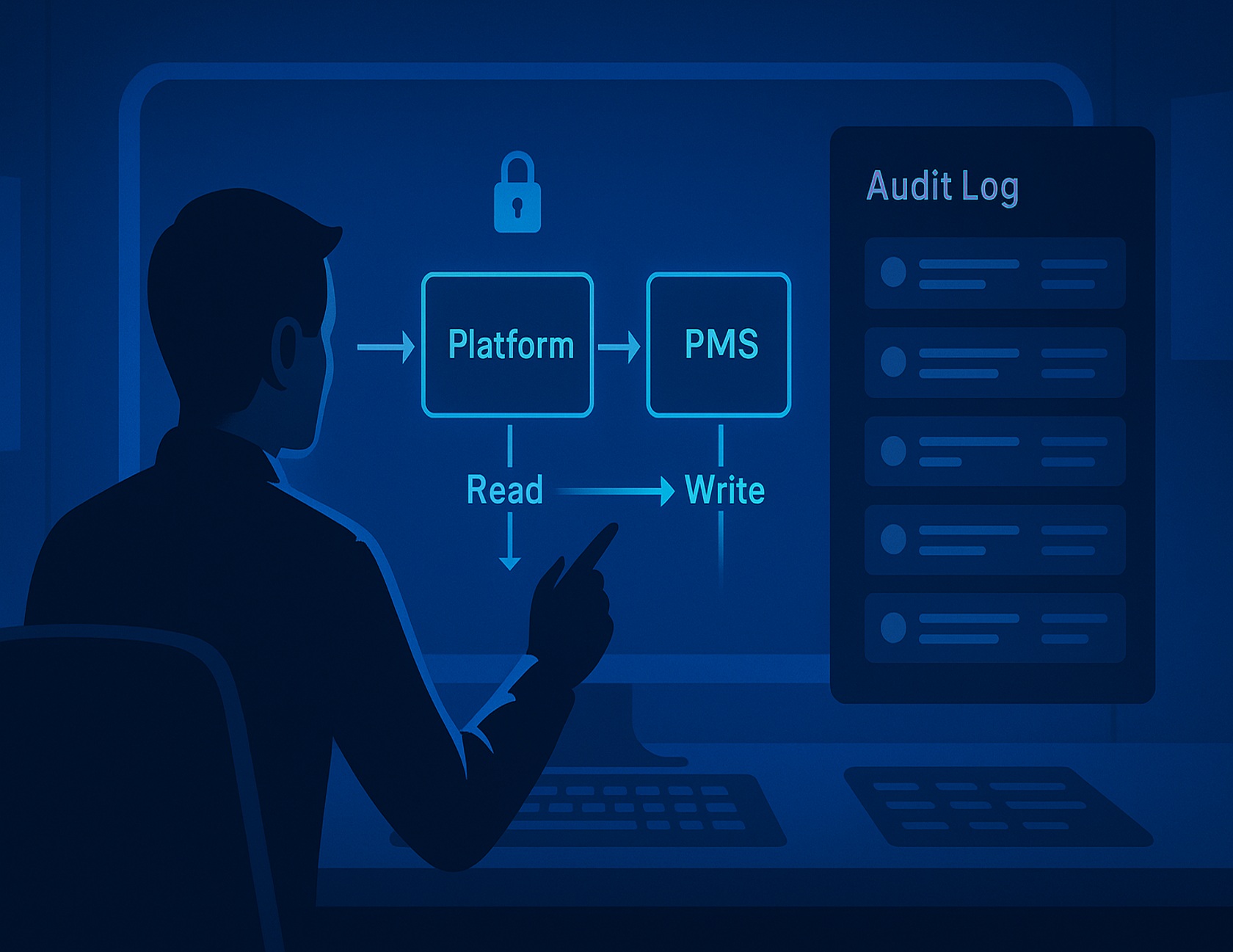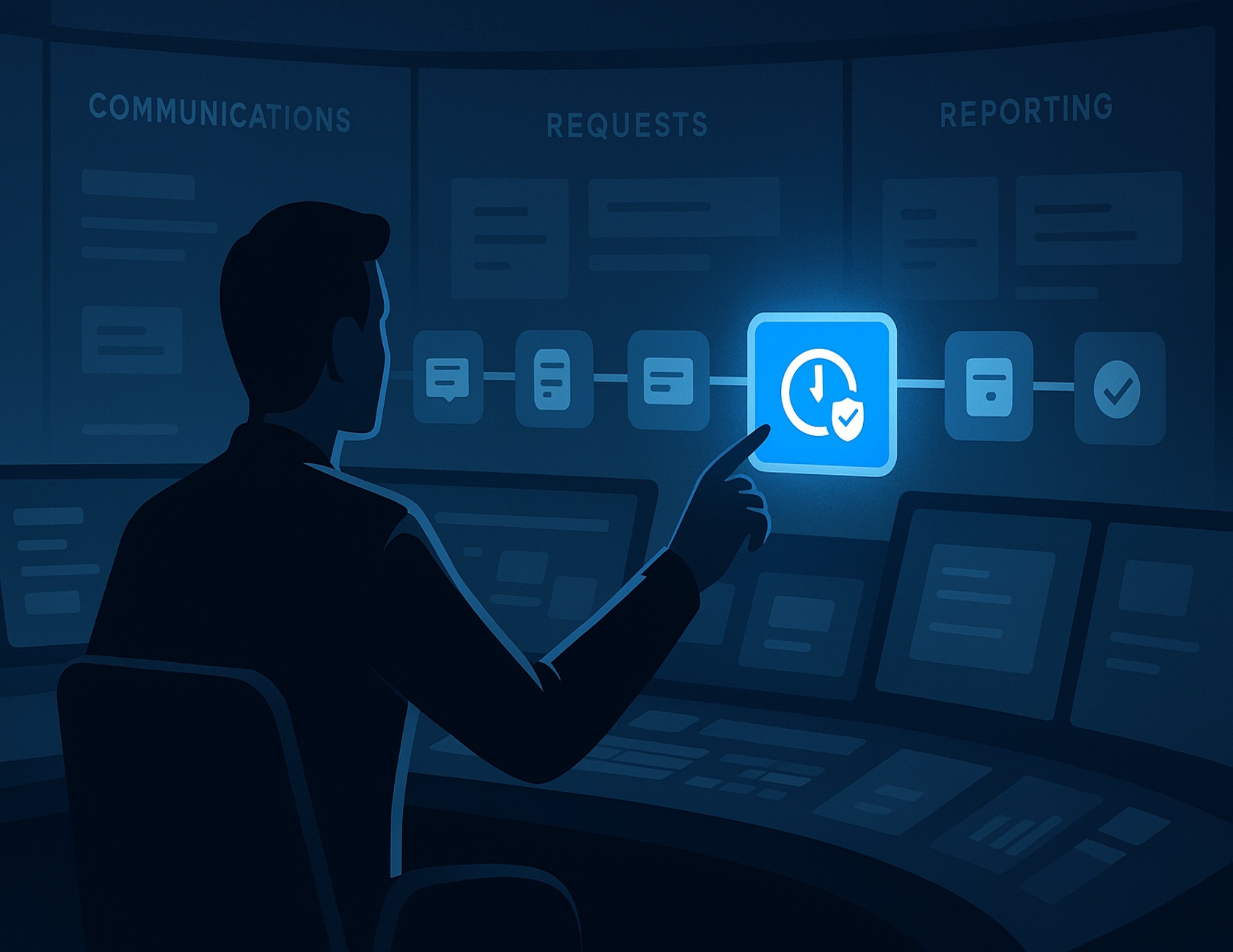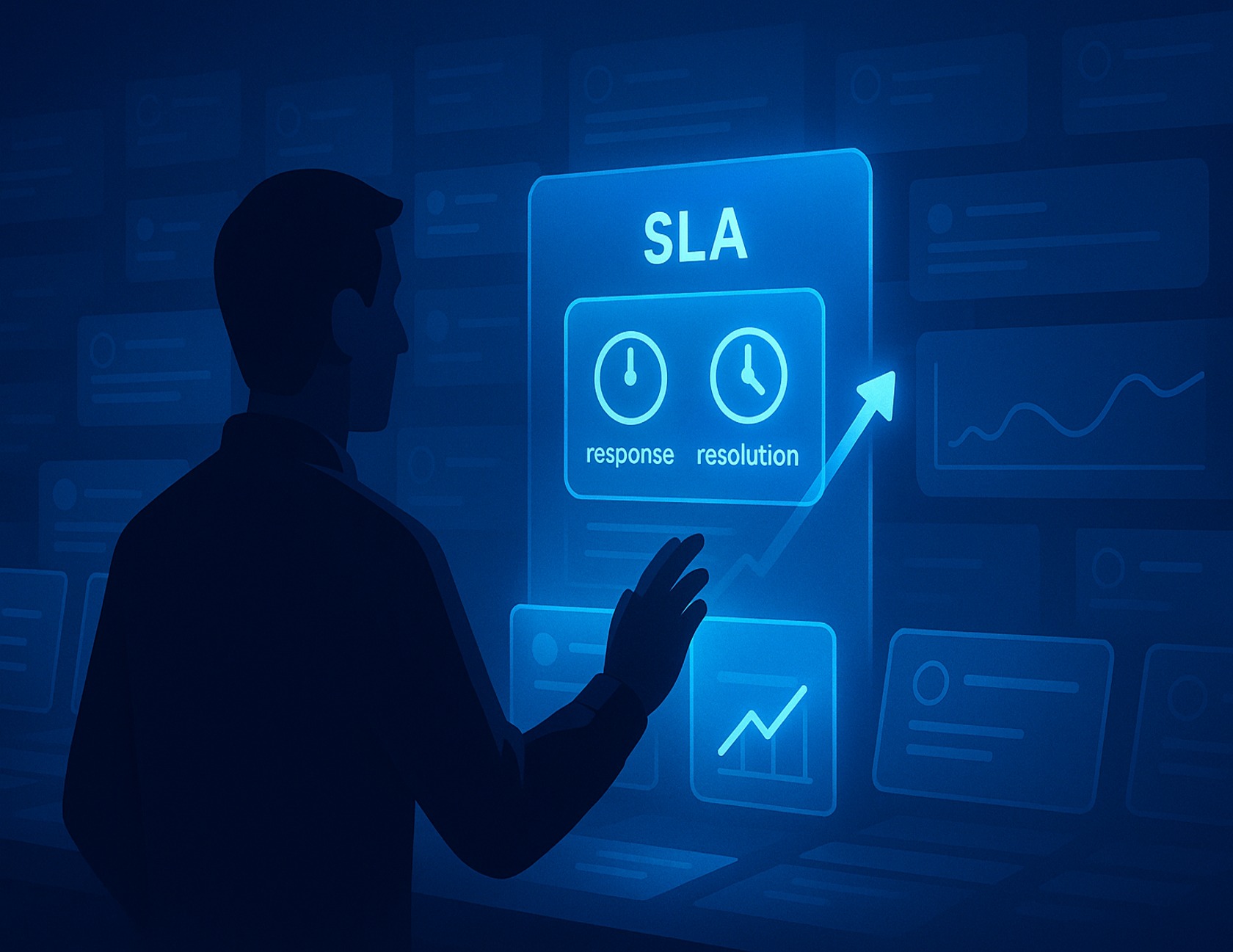
📌 Key Takeaways:
Operational chaos stems from undefined service expectations, not insufficient staff or resources.
Governance Creates Calm: Tiered SLA frameworks with defined response and resolution targets transform reactive firefighting into predictable service orchestration.
Visibility Prevents Blind Spots: Role-based access controls ensure the right stakeholders see appropriate information while maintaining audit trails for accountability and continuous improvement.
Measurement Drives Performance: Systematic variance reporting by category and building reveals chronic bottlenecks and enables data-driven resource allocation decisions.
Platform Enforcement Scales: Automated routing, escalation triggers, and workflow controls embedded in resident experience platforms ensure consistent SLA adherence across shifts and seasons.
Pilot-First Implementation: Starting with 5-7 high-volume request categories in a single building proves effectiveness before committing to portfolio-wide standardization and scaling.
Systematic SLA governance transforms ambiguous service expectations into measurable operational excellence.
For Class A property management teams seeking to replace escalations and firefighting with predictable service delivery, these frameworks provide the foundation for operational transformation.
In Brief: For Class A communities, calm isn't luck—it's governed. A resident experience platform enforces tiered SLAs, aligns expectations across roles, and exposes variance so leaders can fix bottlenecks. This guide compares SLA models, shows what to standardize, and ships with a ready-to-use SLA taxonomy table.
Why SLA Governance Determines Calm (Not Just Speed)
Peak periods reveal the fault lines. When weekend amenity bookings collide with maintenance emergencies, unclear service expectations become escalations. The difference between firefighting and orchestrated operations often comes down to one factor: whether your community operates with governed service level agreements.
An SLA taxonomy translates strategy into day-to-day operations. It aligns categories (what residents ask for), commitments (what "good" looks like), and controls (who can see and change what). Done well, it functions like an operations control room: one source of truth, prioritized queues, and predictable handoffs.
Ambiguity in service expectations creates a cascade of operational friction. Without defined response targets, residents form their own assumptions about urgency. Property management teams operate without clear prioritization frameworks. The result is predictable: missed expectations, duplicate efforts, and escalations that could have been prevented.
Response vs. Resolution: Define Both
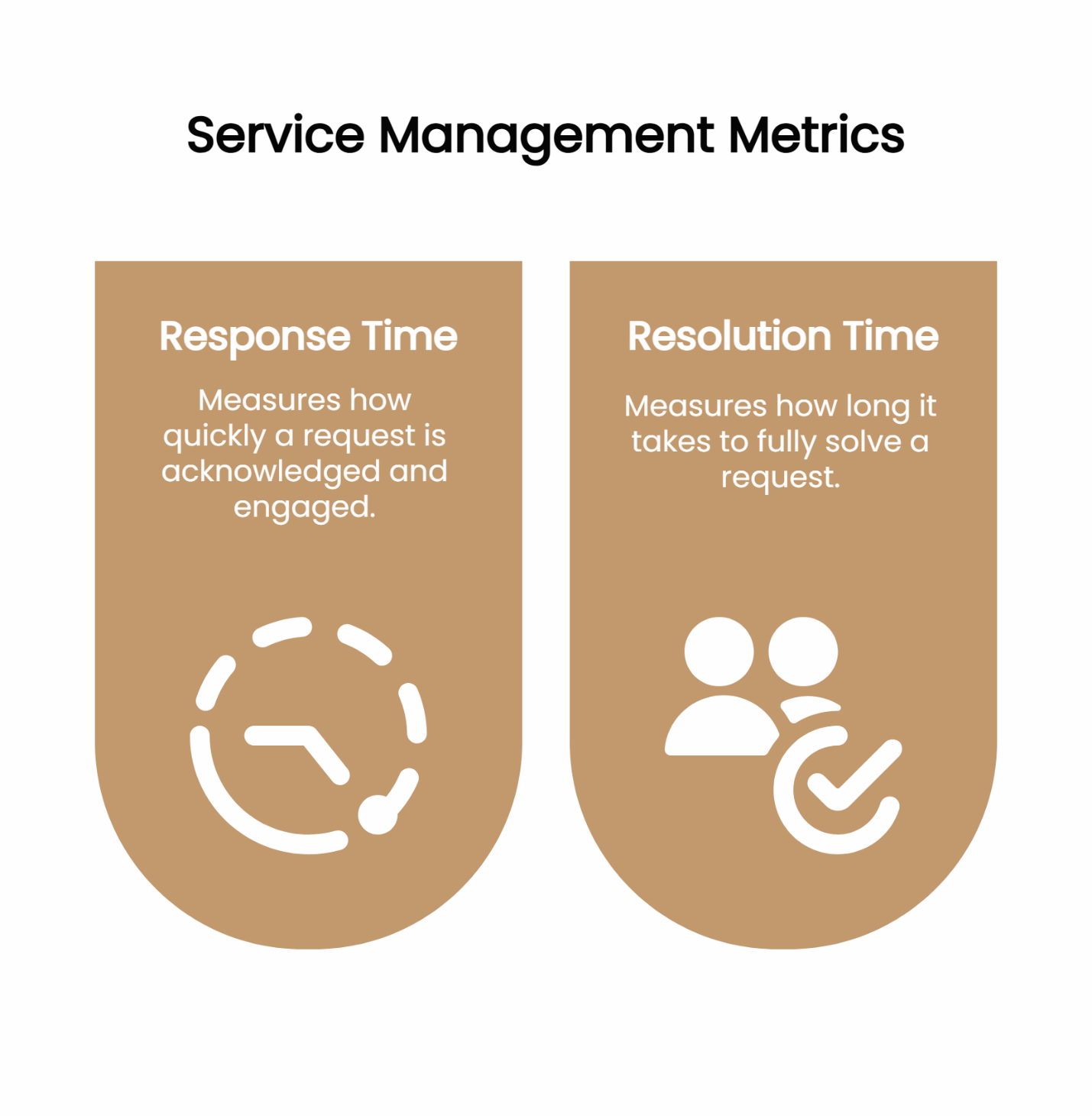
Most communities focus solely on resolution time—how long it takes to fully complete a request. However, residents often care more about acknowledgment and initial action. Response time measures how quickly the request is acknowledged and engaged; resolution time measures how long until it's fully solved. Both are standard in service management and can be configured and reported directly in modern tools.
Setting both targets reduces the ping-pong effect where residents follow up because they haven't received confirmation their request was received. A maintenance request might have a 15-minute response target (acknowledgment and initial assessment) and a 4-hour resolution target (completion). This dual approach manages expectations while providing operational flexibility.
Platform Enforcement vs. Policy on Paper
Written policies mean little without systematic enforcement. A resident experience platform automatically routes requests based on SLA tiers, triggers alerts when response windows are approaching, and escalates according to predefined rules. The platform becomes the enforcement mechanism, not individual memory or manual processes.
This systematic approach enables consistent service delivery across shifts, seasons, and staff changes. When governance is embedded in the operational platform rather than relying on manual adherence, service levels become predictable rather than dependent on individual attention spans.
Comprehensive SLA Taxonomy Framework
Effective SLA governance requires a detailed framework that goes beyond simple time-based targets. The following taxonomy covers the essential metrics that Class A communities need for systematic service management.
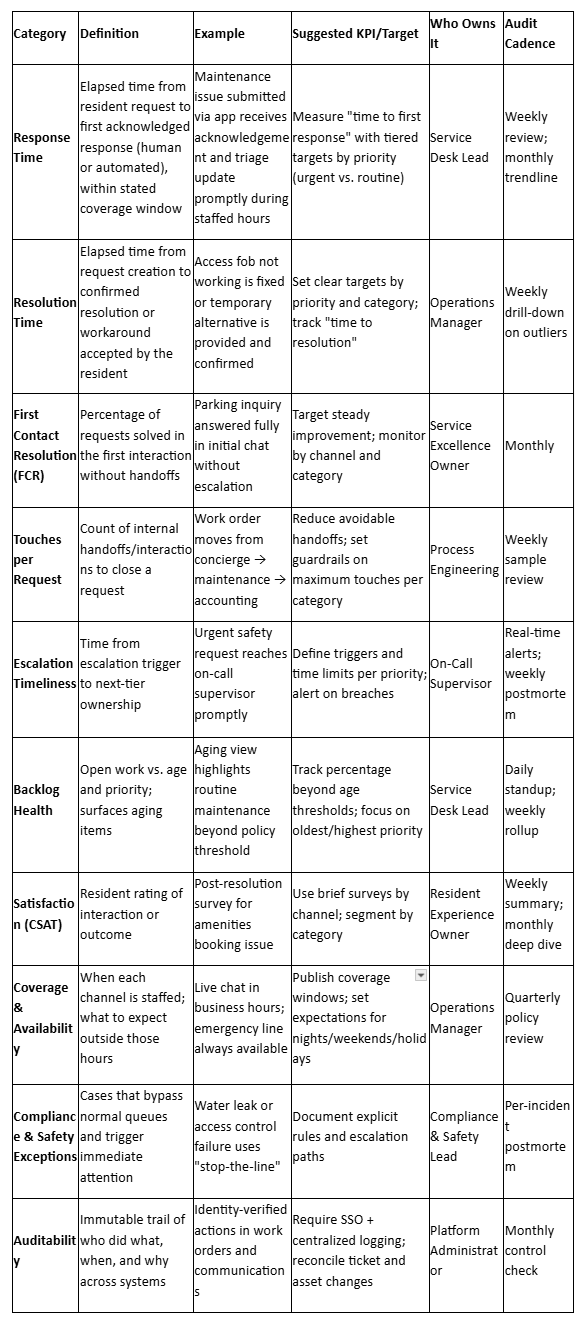
This comprehensive framework moves beyond basic time-based metrics to include outcome measures, process efficiency indicators, and governance controls that ensure systematic service delivery.
Comparative Guide: SLA Model Trade-offs
Different SLA approaches serve different operational philosophies. Understanding the trade-offs helps communities select models that align with their staffing, resident expectations, and operational complexity.
Time-Based vs. Outcome-Based SLAs
Time-based SLAs (response/resolution clocks) are simple to implement and explain. They fit triage-driven work and make breaches visible, providing clear accountability and measurable performance standards. Property management teams know exactly when responses and resolutions are due, enabling proactive resource allocation.
However, time-based models can create perverse incentives. Staff might prioritize meeting time targets over providing thoughtful solutions. Outcome-based SLAs (such as First Contact Resolution, satisfaction scores, or "no repeat within 7 days") better reflect resident outcomes and discourage superficial "fast but incomplete" closes.
Most effective implementations start time-based for clarity, then layer outcome metrics once categories stabilize. This hybrid approach provides the predictability residents expect while maintaining focus on resolution quality and resident satisfaction.
Coverage Hours: Business, Extended, or 24/7
Coverage is both a promise and a cost line. Business-hours coverage concentrates expertise when volume peaks and provides cost-effective service for routine requests. Extended hours add evening and weekend accessibility for equitable resident experience, particularly important for working residents who can't address issues during traditional business hours.
True 24/7 coverage is appropriate for life-safety categories but expensive if applied universally. The key is publishing a coverage matrix by channel and category while avoiding implied promises outside published windows. Consistency across markets matters for expectations management, particularly for portfolio-level operations.
Round-the-clock availability for safety and access issues aligns with Class A resident expectations, while other requests can be acknowledged but resolved during business hours with clear communication about coverage hours and emergency escalation paths.
Ownership: Centralized vs. Distributed
Centralized ownership (one service desk) reduces handoffs and simplifies reporting while providing consistent service standards across all request types. This model works well for smaller portfolios or communities with generalist staff who can handle diverse request types.
Distributed ownership (specialist queues) improves depth and speed for complex categories, allowing subject matter experts to handle specialized requests more efficiently. The challenge lies in preventing requests from falling through gaps between specialist areas.
Many portfolios adopt a hybrid approach: centralized intake and triage with distributed fulfillment, clear "stop-the-line" triggers, and time-boxed escalations. This model combines the benefits of consistent initial handling with specialized resolution capabilities.
Role-Based Visibility and Access Control
Effective SLA governance requires different stakeholders to see appropriate information at the right times while maintaining security and operational efficiency. Modern access control frameworks provide the foundation for systematic visibility management.
Governance and Access Implementation
Centralize identity (SSO), authorization (least privilege), and logs (immutable, queryable). The NIST SP 800-53 Rev. 5 framework organizes access control and audit logging controls and provides mappings to other frameworks, including ISO/IEC 27001:2022, establishing industry-standard approaches for role-based access.
Enforce change control on workflow and routing rules with peer review processes. Instrument response and resolution clocks at intake, not after triage, to ensure accurate measurement from the resident's perspective. Create escalation runbooks per priority with time-boxed "next-owner" targets that prevent requests from aging inappropriately.
Operational Roles and Information Needs
Property management teams need comprehensive visibility into request status, aging reports, and escalation triggers. This operational view enables proactive resource allocation and prevents issues from falling through communication gaps. Access to historical patterns helps identify chronic problems and staffing needs.
Concierge and front desk staff require real-time status updates for resident-facing communications. When residents inquire about request status, front desk teams need immediate access to current information, expected resolution timeframes, and any complications that might affect delivery.
Residents benefit from transparency about their specific requests without visibility into overall operational complexity. A resident should see their request status, expected resolution timeframes, and communication updates while remaining insulated from internal operational details or other residents' issues.
Escalation and Audit Controls
Declare "stop-the-line" rules for safety and compliance issues that bypass normal queues and trigger immediate attention. Clear escalation paths prevent requests from aging inappropriately while avoiding unnecessary management interruption. Automatic escalation triggers based on elapsed time ensure nothing gets forgotten.
Maintain end-to-end audit logs for tickets, assets, and communications, with change control on workflows and routing rules. Reconcile ticket history with asset changes weekly to prove completeness and identify any gaps in the audit trail that might indicate process failures or security concerns.
Variance Reporting and Queue Health Management
Measuring SLA performance systematically transforms operational management from reactive firefighting to proactive optimization. However, effective variance reporting requires understanding the underlying dynamics that cause service delays.
Understanding Queue Behavior
Queues misbehave when variability is unmanaged. In networks of queues, dependencies and feedback loops (rework, callbacks) create spillbacks and blocking effects. Capacity looks adequate on paper yet waits grow non-linearly due to these complex interactions.
This phenomenon is well-studied in queueing networks and represents a predictable source of delays in operations teams. Understanding these effects helps property management teams design more resilient service processes rather than simply adding more staff to address symptoms.
Managing Variance Systematically
Manage variance with smaller work-in-progress limits, clear priority bands, and aging views that highlight the oldest items first to prevent cascades. Monitor variance reports that show performance against SLA targets by tier, identifying both successes and systematic gaps that require attention.
Weekly variance rollups should combine performance data with operational context. Understanding whether missed targets resulted from staff shortages, unusual request volumes, external vendor delays, or process gaps enables appropriate corrective action rather than generic performance pressure.
Effective Weekly Cadence
Roll up breaches and aging by category and property, highlighting repeat causes that indicate systematic problems rather than individual incidents. Review 5-10 outliers with runbook adherence and handoff count analysis—fix the rule, not just the ticket, to prevent recurring issues.
Publish a brief "what residents can expect this week" note if coverage or volumes will differ due to holidays, maintenance projects, or other planned variations. This proactive communication prevents unrealistic expectations during atypical periods.
Portfolio-level reporting enables leadership to identify best practices and resource allocation opportunities across multiple communities. Comparing performance across similar properties can reveal process innovations, staffing models, or technology implementations that drive superior results.
Implementation Roadmap: Pilot → Standardize → Scale
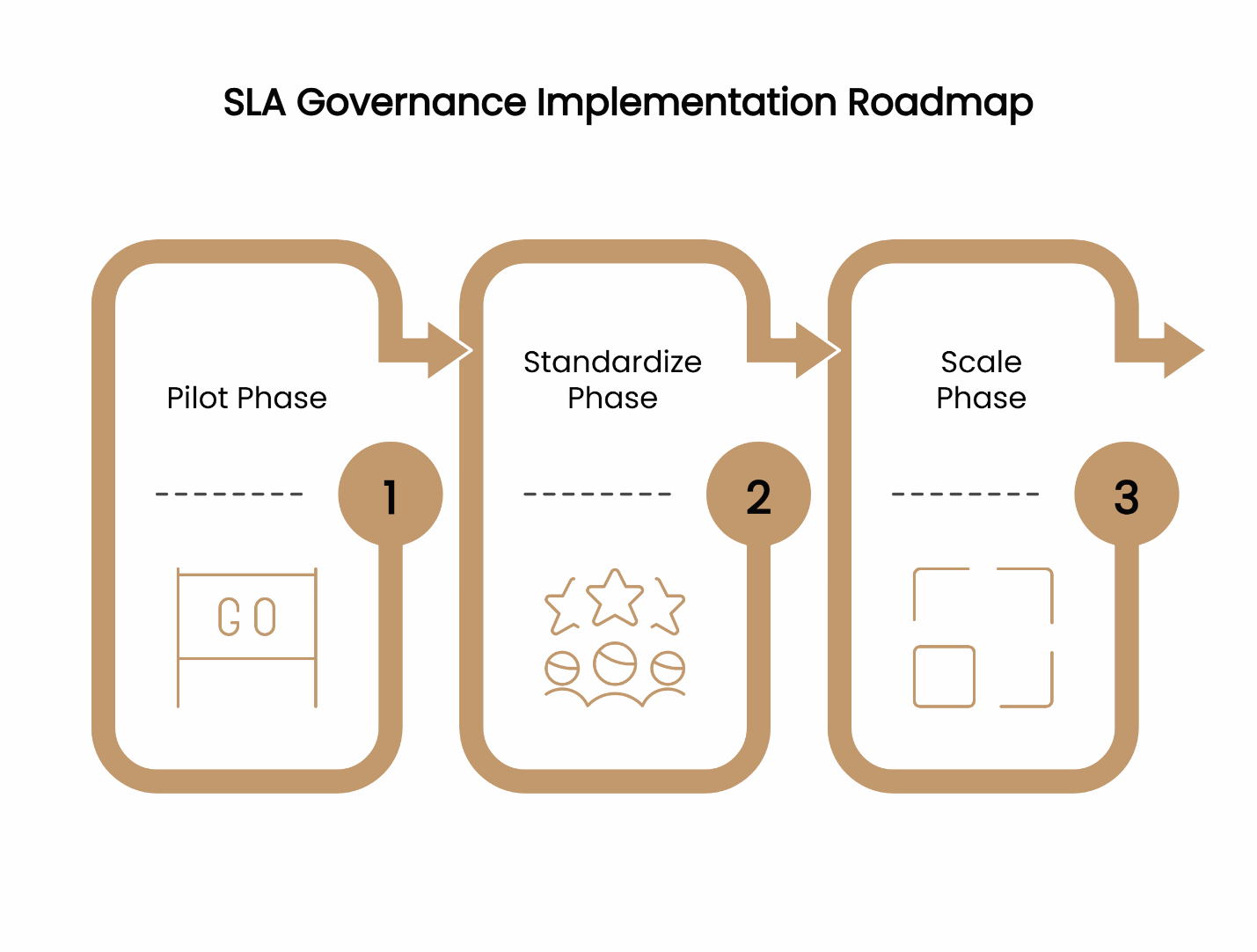
Successful SLA governance implementation follows a disciplined approach that proves effectiveness before committing to portfolio-wide changes. This methodical process reduces implementation risk while building stakeholder confidence.
Pilot Phase (30-60 Days)
Choose 5-7 high-volume categories and publish response/resolution targets for focused testing. Run daily standups on backlog health to identify immediate process issues. Use templated workflows to remove avoidable touches and confirm who owns each metric before expanding scope.
Pilot implementations should focus on a single community with representative characteristics and willing operational staff. Within the pilot building, begin with one high-volume request type that has clear success criteria. Maintenance requests often work well because they have measurable resolution outcomes and involve multiple stakeholders.
Document everything during the pilot phase. Capture not just performance metrics, but also implementation challenges, staff feedback, resident reactions, and unexpected complications. This documentation becomes the foundation for standardization and scaling decisions.
Standardize Phase
Lock the taxonomy and publish the coverage matrix based on pilot learning. Enable variance reporting with weekly rollups and breach postmortems to identify systematic issues. Add outcome metrics (First Contact Resolution, satisfaction) once data quality is stable and time-based metrics are consistently met.
Develop standardized procedures that can be consistently applied across communities. Approval workflows should specify decision authority for different request types and escalation scenarios. Clear authorization prevents delays while maintaining appropriate oversight.
Channel definitions should specify how different request types enter the system, how information flows between stakeholders, and how residents receive updates. Consistency in communication channels reduces confusion and ensures nothing gets lost between systems or team members.
Scale Phase
Expand to additional properties and channels with sequential implementation that enables knowledge transfer. Automate escalations and codify "stop-the-line" rules to reduce manual oversight requirements. Instrument audit trails across systems to ensure governance scales with operations.
Implement change control procedures that prevent unauthorized modifications during scaling. SLA governance only works when applied consistently, and change control prevents well-intentioned local modifications that undermine systematic benefits.
Portfolio rollout should be phased to allow learning and adjustment without overwhelming support resources. Sequential implementation across communities enables knowledge transfer and support concentration while building systematic evidence of effectiveness.
Architecture and Technical Integration
The technical foundation determines whether SLA governance remains manual overhead or becomes systematic enforcement. Proper architecture choices enable automation, auditability, and scalability.
Identity and Access Foundation
Use SSO with least-privilege roles so visibility is role-based and consistent across the technology stack. Align identity assurance and authentication strengths to risk levels, using higher assurance where safety-critical actions occur. This approach follows NIST Digital Identity Guidelines for systematic risk management.
Centralize identity, authorization, and logging to create immutable, queryable audit trails. This centralization enables consistent access control while supporting the detailed audit requirements that governance frameworks demand.
Integration with Property Management Systems
Seamless integration with existing property management software ensures SLA governance doesn't create additional administrative burden. The platform should automatically create tickets from resident requests, route them according to SLA rules, and update status without manual intervention.
Integration requirements include bi-directional data flow, real-time status updates, and consolidated reporting that combines SLA metrics with operational data. This integration transforms the resident experience platform from an additional system into the operational backbone for service delivery.
Automation and Escalation
Configure automatic escalations based on SLA targets and aging thresholds. The system should alert appropriate stakeholders when targets are approaching and escalate according to predefined rules without manual monitoring. This automation ensures consistent enforcement while reducing administrative overhead.
Implement workflow automation that routes requests to appropriate queues, applies SLA targets based on categorization, and triggers necessary approvals or specialist involvement. Well-designed automation reduces touches per request while maintaining appropriate oversight and quality control.
Frequently Asked Questions
What's the difference between response time and resolution time?
Response time measures acknowledgment and first action, while resolution time measures full completion. Setting both targets reduces back-and-forth communication and manages resident expectations throughout the process.
How many SLA tiers work best for Class A communities?
Three priority bands (urgent, standard, low) are usually sufficient to start. More tiers often add noise without better outcomes, while too few create overly broad categories that don't provide meaningful prioritization.
What if a request spans multiple systems?
Start the clocks at first intake and continue through handoffs. Use centralized logging and role-based visibility so owners can act without duplicating work. This approach maintains accountability while preventing administrative overhead.
How should weekend and holiday requests be handled?
Publish coverage by channel and category. For safety-critical categories, use "stop-the-line" handling with explicit on-call ownership; for others, communicate the next staffed window and set expectations in-app.
Request a 20-minute Architecture Brief: Discuss how SLA governance integrates with your current governance, coverage, and escalation choices mapped to this taxonomy.
Get the SLA Taxonomy Table: Contact us to receive a customizable version of the comprehensive framework with implementation guidance tailored for your portfolio.
This article provides educational information about SLA governance frameworks. Property management teams should confirm specific requirements with operational leadership and adapt frameworks to their unique community characteristics.
Our Editorial Process:
Evidence-first content development with sources reviewed within 36 months; inclusive language review; regular updates based on industry guidance changes.
About ElevateOS
ElevateOS partners with Class A communities to deliver comprehensive resident experience solutions that unify operations, enhance resident satisfaction, and support portfolio growth through integrated technology and service delivery.

.avif)
